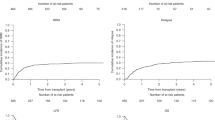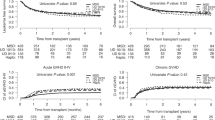Abstract
It is not known if donor–recipient ABO blood group incompatibility contributes to graft-versus-leukemia after allogeneic BMT. One hundred and nineteen patients with acute myeloid leukemia in first remission underwent non-T cell-depleted marrow allografts from HLA-identical siblings after TBI and cyclophosphamide (n = 72) or melphalan (n = 47). GVHD prophylaxis comprised cyclosporine alone or cyclosporine-methotrexate. Twenty-two patients relapsed at 3–46 months (median 7): 18 of 76 patients with ABO-matched donors and four of 43 patients with ABO-mismatched donors (actuarial 5-year probabilities 33 ± 6% vs 12 ± 6%; P = 0.028). The incidence of acute and chronic GVHD was not affected by ABO mismatch. The following factors were studied in Cox analysis for effect on outcome: gender, age, FAB subtype, ABO mismatch, CR–transplant interval, conditioning, TBI dose, nucleated cell dose, lymphocyte recovery, acute GVHD, and chronic GVHD. Donor–recipient ABO match was the only factor independently associated with a higher risk of relapse (RR = 3.7; 95% Cl, 1.1–12.6; P = 0.04). ABO mismatch was also associated with superior overall and disease-free survivals. We conclude that ABO incompatibility may influence relapse rates and survival favorably after allogeneic BMT. It is not known if this holds true for allogeneic blood stem cell transplants.
This is a preview of subscription content, access via your institution
Access options
Subscribe to this journal
Receive 12 print issues and online access
$259.00 per year
only $21.58 per issue
Buy this article
- Purchase on Springer Link
- Instant access to full article PDF
Prices may be subject to local taxes which are calculated during checkout




Similar content being viewed by others
References
Weiden PL, Flournoy N, Thomas ED et al. Antileukemic effect of graft-versus-host disease in human recipients of allogeneic marrow grafts New Engl J Med 1979 300: 1068 1073
Weiden PL, Sullivan KM, Flournoy N et al. Antileukemic effect of chronic graft-versus-host disease: contribution to improved survival after allogeneic marrow transplantation New Engl J Med 1981 304: 1529 1533
Horowitz MM, Gale RP, Sondel PM et al. Graft-versus-leukemia reactions after bone marrow transplantation Blood 1990 75: 555 562
Powles R, Mehta J, Kulkarni S et al. Allogeneic blood and bone-marrow stem-cell transplantation in haematological malignant diseases: a randomised trial Lancet 2000 355: 1231 1237
Bensinger WI, Martin PJ, Storer B et al. Transplantation of bone marrow as compared with peripheral-blood cells from HLA-identical relatives in patients with hematologic cancers New Engl J Med 2001 344: 175 181
Sniecinski IJ, Oien L, Petz LD et al. Immunohematologic consequences of major ABO-mismatched bone marrow transplantation Transplantation 1988 45: 530 534
Klumpp TR . Immunohematologic complications of bone marrow transplantation Bone Marrow Transplant 1991 8: 159 170
Mehta J, Powles R, Singhal S et al. Transfusion requirements after bone marrow transplantation from HLA-identical siblings: effects of donor–recipient ABO incompatibility Bone Marrow Transplant 1996 18: 151 156
Benjamin RJ, McGurk S, Ralston MS et al. ABO incompatibility as an adverse risk factor for survival after allogeneic bone marrow transplantation Transfusion 1999 39: 179 187
Stussi G, Seebach L, Muntwyler J et al. Graft-versus-host disease and survival after ABO-incompatible allogeneic bone marrow transplantation: a single-centre experience Br J Haematol 2001 113: 251 253
Bensinger WI, Buckner CD, Thomas ED et al. ABO-incompatible marrow transplants Transplantation 1982 33: 427 429
Ne ME eds McCarthy DM, Barrett J . ABH and Lewis antigen and antibody expression after bone marrow transplantation Acta Haematol 1987 78: 13 16
Geller RB, Saral R, Piantadosi S et al. Allogeneic bone marrow transplantation after high-dose busulfan and cyclophosphamide in patients with acute nonlymphocytic leukemia Blood 1989 73: 2209 2218
Mehta J, Powles R, Horton C et al. The relationship between donor–recipient blood group incompatibility and serum bilirubin after allogeneic bone marrow transplantation from HLA-identical siblings Bone Marrow Transplant 1995 15: 853 858
Mielcarek M, Leisenring W, Torok-Storb B et al. Graft-versus-host disease and donor-directed hemagglutinin titers after ABO-mismatched related and unrelated marrow allografts: evidence for a graft-versus-plasma cell effect Blood 2000 96: 1150 1156
Mehta J, Powles R, Treleaven J et al. Long-term follow-up of patients undergoing allogeneic bone marrow transplantation for acute myeloid leukemia in first complete remission after cyclophosphamide-total body irradiation and cyclosporine Bone Marrow Transplant 1996 18: 741 746
Helenglass G, Powles RL, McElwain TJ et al. Melphalan and total body irradiation (TBI) versus cyclophosphamide and TBI as conditioning for allogeneic matched sibling bone marrow transplants for acute myeloblastic leukaemia in first remission Bone Marrow Transplant 1988 3: 21 29
Hjiyannakis P, Mehta J, Milan S et al. Melphalan, single-fraction total-body irradiation and allogeneic bone marrow transplantation for acute leukaemia: review of transplant-related mortality Leuk Lymphoma 1997 25: 565 572
Mehta J, Powles R, Treleaven J et al. Melphalan versus cyclophosphamide with total body irradiation as conditioning for allogeneic bone marrow transplantation in first remission acute myeloid leukemia Blood 1994 84: (Suppl. 1) 714a
Powles R, Singhal S, Treleaven J et al. Identification of patients who may benefit from prophylactic immunotherapy after bone marrow transplantation for acute myeloid leukemia on the basis of lymphocyte recovery after transplantation Blood 1998 91: 3481 3486
Mehta J, Powles R, Treleaven J et al. Outcome of acute leukemia relapsing after bone marrow transplantation: utility of second transplants and adoptive immunotherapy Bone Marrow Transplant 1997 19: 709 719
Singhal S, Powles R, Kulkarni S et al. Long-term follow-up of relapsed acute leukemia treated with immunotherapy after allogeneic transplantation: the inseparability of graft-versus-host disease and graft-versus-leukemia, and the problem of extramedullary relapse Leuk Lymphoma 1999 32: 505 512
Benjamin RJ, Antin JH . ABO-incompatible bone marrow transplantation: the transfusion of incompatible plasma may exacerbate regimen-related toxicity Transfusion 1999 39: 1273 1274
Bacigalupo A, Van Lint MT, Occhini D et al. ABO compatibility and acute graft-versus-host disease following allogeneic bone marrow transplantation Transplantation 1988 45: 1091 1094
Kalaycioglu M, Copelan E, Avalos B et al. Survival after ABO-incompatible allogeneic bone marrow transplant after a preparative regimen of busulfan and cyclophosphamide Bone Marrow Transplant 1995 15: 105 110
van der Mast BJ, Vietor HE, van der Meer-Prins EM et al. Modulation of the T cell compartment by blood transfusion. Effect on cytotoxic and helper T lymphocyte precursor frequencies and T cell receptor Vbeta usage Transplantation 1997 63: 1145 1154
Rooney CM, Munro AJ . NK cells can recognize asialylated autologous lymphocytes and ABO-mismatched lymphocytes Immunology 1984 51: 193 199
Acknowledgements
This study was supported by the Bud Flanagan Leukaemia Fund, the David Adams Leukaemia Fund, the Cancer Research Campaign and the Institute of Cancer Research.
Author information
Authors and Affiliations
Rights and permissions
About this article
Cite this article
Mehta, J., Powles, R., Sirohi, B. et al. Does donor–recipient ABO incompatibility protect against relapse after allogeneic bone marrow transplantation in first remission acute myeloid leukemia?. Bone Marrow Transplant 29, 853–859 (2002). https://doi.org/10.1038/sj.bmt.1703545
Received:
Accepted:
Published:
Issue Date:
DOI: https://doi.org/10.1038/sj.bmt.1703545
Keywords
This article is cited by
-
Red blood cell-incompatible allogeneic hematopoietic progenitor cell transplantation
Bone Marrow Transplantation (2011)
-
Lack of effect of donor–recipient ABO mismatching on outcome following allogeneic hematopoietic stem cell transplantation
Bone Marrow Transplantation (2006)
-
What would Karl Landsteiner do? The ABO blood group and stem cell transplantation
Bone Marrow Transplantation (2005)
-
ABO-incompatible bone marrow transplantation: a GITMO survey of current practice in Italy and comparison with the literature
Bone Marrow Transplantation (2004)
-
ABO incompatibility and relapse risk in patients undergoing allogeneic marrow transplantation for acute myeloid leukemia
Bone Marrow Transplantation (2002)



